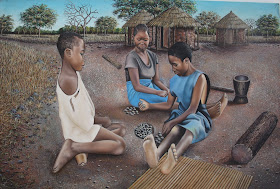By Andrew
Mulenga
Two years
down the line the Livingstone Gallery, the first purpose built contemporary art
space in Zambia, nestled in the country’s tourist capital appears to be subsisting
albeit in a happy-go-lucky way.
Much has
been said about the quality of the building itself and the hurried manner in
which it was constructed, but the gallery’s manager Chansa Chishimba a locally
respected multidisciplinary artist hints that all is well as he gives insights
on how the space has been getting by since its opening.
 |
| Livingstone gallery manager Chansa Chishimba |
“Always
when you have a new born baby the family members are apprehensive and ask, will
the child grow or not? but anyway slowly things have started improving. Of late
we have been receiving calls for bookings from as far as the Copper belt and
Europe where people will write you an e-mail in advance requesting a tour
booking for a specific day,” says the 60-year-old artist well-known for a
technique in which he processes traditional tree bark fiber cloths for his art
work.
“On
average daily visits to the gallery are quite sporadic, there are times when we
have no visitor at all. Then all of a sudden we have a bus of over 60 people.
So we tally, I can say we receive a minimum of 8 people a day, we record, the
statistics, they are important because the National Arts Council (NAC) and the
ministry of tourism want to know these things,” he explains.
 |
| The gallery's dirt track off Sichango Road lends a Safari feel to the art space |
He
indicates that during this data collection the gallery identifies what type of
visitors are coming through whether male, female, adult, children or foreign. Chansa
says the money too is not coming as fast as he wished, but at least the gallery
is able to sell one piece every two months.
“Sales
are very unpredictable, you can’t tell whether you are going to sell this month
or not, but since the opening in 2014 I remember the first exhibition we sold K41,070
(approx. US$ 3,700) that exhibition, we mounted a second show and sold 51,150 (approx.
US$ 4,700) – on average a show lasts 3 months he says.
Since the
gallery opened it has only had three themed shows with what he called fillers
in between, exhibitions such as the one currently showing which is basically a mixture
of work in various media by artists at different career level from all corners
of the country are hung and placed randomly.
 |
| The display is usually a mixture of work in various media by artists at different career level from all corners of the country |
“When we
mounted a filler in April this year we did not sell anything, but in May we
sold K11,700 this was for about five pieces (five works of art) so we hope June
being a peak period for the tourists who come here for their summer holidays, we
might be able to realize some sales,” he explains.
He points
out that the gallery is able to remain operational because of the direct
support from NAC and the Ministry of tourism through the District Cultural Office
who cater for the monthly volunteer staff wages, and utilities.
“Every
month we have something to pay for electricity, water that one is budgeted for,
government has put it as a priority. We are not complaining I’m paid under NAC.
Whoever comes to sit here NAC will find something to ‘wash their hands’ (pay
wages) according to the individual if the can agree to the terms. Already Kate
Naluyele and Gill Zulu as my assistants they have come with new ideas and I
think things will start moving,” he says.
 |
| Abraham Banda, Chiato, Acrylic on canvas |
Naluyele
is the current Visual Arts Council (VAC) national vice chairperson, who has
relocated from Lusaka and Zulu runs Highlands Creative Academy while she is also
the Visual Arts Development manager for Elijah International Zambia, both are
working primarily as volunteers although they receive a stipend from NAC.
Meanwhile,
Zulu who comes to the gallery once a week also echoed that the space is gaining
ground with regards group tours.
 |
| Isaac Kalambata, Burning Desire, Acrylic on canvas |
“What we
really have to do is intensify our marketing strategy. We need to make the
gallery an active, not passive experience. We hope to have frequent
entertainment activities where creatives come for social events on a regular
basis and we are trying to get the venue promoted to the broader community, for
the Chinese exhibition project a shelter was built for artists to work in so we
can also continue using that,” says Zulu.
The gallery
is on Sichango Road, behind Livingstone Showgrounds, you cannot miss the
elaborate roadside sign post which features two giraffe sculptures holding up a
wooden plaque that reads “art gallery”.
Nevertheless,
although there is still a lot of room for improvement with the Livingstone
Gallery, one can safely say Zambia finally has the semblance of a national art
gallery, but as to whether the space will take up the responsibility of
challenging the aesthetic, historical, cultural and socio-political implications
of art in Zambia or play the role of an elevated curio shop this is yet to be
seen.
Chishimba Chansa is a sculptor, ceramist, textile
designer and painter who holds diplomas from the Nkwame Nkrumah Teachers
College in Kabwe and Evelyn Hone College of applied Arts and Commerce in Lusaka
and the HDK School of Design and Crafts at the University of Gothenburg, Sweden.












